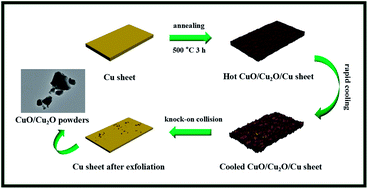Facile thermal exfoliation of Cu sheets towards the CuO/Cu2O heterojunction: a cost-effective photocatalyst with visible-light response for promising sustainable applications†
Abstract
Unlike semiconductors, metals, especially the Cu element, usually show preeminent ductility and thermal expansivity; accordingly, herein, we report thermal treatment of a commercial copper sheet in air to obtain a black mass, i.e. CuO/Cu2O with a heterojunction, which has been proven to be a photocatalyst. Rapid cooling of the hot sheet detached/knocked off the oxidized layers from the sheet as a powder. The extent of the formation of copper oxides was determined by electrochemical impedance spectroscopy and transient photocurrent responses; in addition, other physical methods for the characterization of the catalyst were performed, and the catalyst exhibited applications in the mineralization of the rhodamine B (RhB) dye, a potential pollutant in water bodies. Moreover, the well-matched band structures of CuO/Cu2O manifested that CuO and Cu2O could serve as reduction sites and hole oxygen sites to generate the ·O2− and ·OH species, respectively, which were subsequently affirmed by the DMPO electron spin resonance technique. In this study, we proposed a novel perspective towards the design of heterogeneous photocatalysts for organic pollutant treatment through a convenient solid-phase synthesis rather than a complicated liquid-phase synthesis. In addition to this, the resultant CuO/Cu2O photocatalyst proposed herein might inspire the researchers to focus on the preparation of more cost-effective photocatalysts for commercialization rather than complicated nanocomposites for pure theoretical research.



 Please wait while we load your content...
Please wait while we load your content...